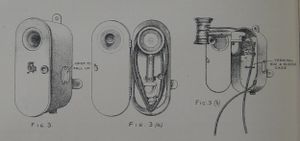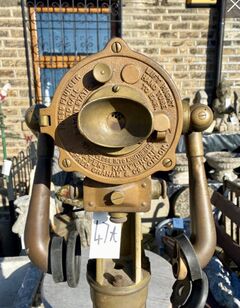Pattern 246X Navyphones

The 246X Pattern Navyphones were a family of Graham navyphones (patterns 2461, 2461A, 2462, 2463, 2464, 2465 and 2466) introduced to service at the dawn of the Super-Dreadnought era for service in Orion. They were powered by motor generator supply and were meant to replace the variety of older instruments recently deployed.
This family used a reliable buzzer rather than a ringing bell as a means of drawing attention to an incoming call, permitted voice call-up, and a new Marzi pattern receiver (excepting patterns 2462 and 2466).[2]
Otherwise, the advantages offered were cited as:
- retention of previous pattern virtues
- addition of a visible "lamp signal" (except in the cabin model, pattern 2462)
- louder and more reliable buzzers in lieu of bells
- use of an alloy ("Suphalium") to reduce weight, though this caused corrosion problems
- removable mouthpieces for cleaning
In 1912, the aluminum alloy of the cases proved very susceptible to corrosion in salt spray, particularly where the securing screws were in place. The manufacturer agreed to supply brass screw bushings for all phones and to outright replace the casings with brass ones for exposed installations.[3]

It looks like an enforcer 'droid. The eyes are a push to call on the left and a call indicating lamp on the right. The lower circle, the receiver horn, the arms have receiver cups on the end, and the torso is a transmitter cone.
This was billed as a "universal navyphone" and a suitable replacement for between 6[5] and 9[6] previous phones:
- Pattern 2140A Navyphone
- Pattern 2108A Navyphone
- Pattern 2108B Navyphone
- Pattern 2109A Navyphone
- Pattern 2109B Navyphone (not mentioned in TDB 1914)
- Pattern 860 Navyphone (not mentioned in TDB 1914)
- Pattern 862 Navyphone (not mentioned in TDB 1914)
- Pattern 863 Navyphone
- Pattern 1856A Navyphone
It first appeared in Orion.[7] It might be telling that the earlier source cites more roles for it than the later one.
The 2461 appears to be the union of all prior phones in its physical presentation: call-up push, a new call indicating lamp, an underslung receiver horn, a pair of movable receiver arms, a front-mounted transmitter. See the images — it looks like an exercise gym set.
A push-to-talk speaking lever beneath the mouthpiece moved aside a solid shutter over the transmitter to reveal a perforated grill and also served to agitate the carbon granules in the transmitter.[8] The right-hand receiver arm activated a switch for answering as in earlier models. The phone weighed 14.5 pounds.[9]
There is not much information regarding the phone's service life cycle, but it may have been superceded by the 2461A soon after introduction.[10] It is not clear whether this or later models ever replaced existing installations.
In late 1913, the captain of Amphion reported that he had removed the indicating lamps from his 2461s in exposed positions, as they proved difficult to remember when darkening ship. The Admiralty decided it was time to warn captains of the necessity of doing this or colouring the glass blue.[11]
These phones were variants of the 2461 with a means to attach an external bell. It appears these supplanted the 2461 immediately after Orion.[12] A set of bell contacts were added, as the buzzer of the 2461 was not proving loud enough in noisy spaces.[13] A 1924 source implies that the purpose of this adaptation may have been to beef up the 2461s that were used in engine rooms.[14]
The 2461 had the same form factor as pattern 2461.[15] It is not clear whether this or later models ever replaced existing installations, but it seems likely from the inference drawn above that some ships with 2461s in engine rooms had these removed in favor of 2461As.[Inference]

This is a very modern-looking handset phone for cabin use, similar in appearance to a Pattern 541 Navyphone. It first appeared in Orion.[17]
It was comprised of a small cylinder mounted on the bulkhead with an L-shaped corded handset on a cord resting atop it (or possibly on the left, though I think the image may be rotated) in a hang-up cradle. Its weight was 5.5 pounds.[18]
It may have been superceded by a model in the 333X line beginning with the Queen Elizabeth class.

This fire control navyphone for use in Transmitting Stations first appeared in Orion.[20] It also saw some "universal use".[21]
The 2463 used the same case as the 2461 phone, with the call-up push and call indicating lamp facing out. Under this chassis was a squat sound horn for the receiver, and a hook in front permitted the handset to be hung in place. A cable gland was provided to permit the optional installation nearby of a pattern 2465 special transmitter, which would be used when a pattern 2463 in the TS were wired to a pattern 2464 in a gun turret. The device weighed 7.625 pounds.[22]
The 2463 may have been superceded by a model in the 333X line beginning with the Queen Elizabeth class.
A modern-style handset makes it appear similar to the Pattern 541 Navyphone.

This fire control navyphone for use at gun positions, conning towers, control towers, and control tops first appeared in Orion.[24] It also saw some "universal use".[25] It was identical to the 2463, but a second receiver was clipped on the back of the main handset receiver and wired to it by a twin core flexible lead,[26] and could be removed to be cupped over the other ear (or another's ear) if desired. It probably lacked or did not actively employ the means of wiring up a pattern 2465 transmitter in tandem.
This device may have been superceded by a model in the 333X line beginning with the Queen Elizabeth class.
Pattern 2465 Special Transmitter

This stem-mounted transmitter would retract against the bulkhead it was mounted to, where a switch on its throat would break the circuit to silence it.
This was not a navyphone in and of itself, but a transmitter to be used in conjunction with a pattern 2463 navyphone mounted in the transmitting station. It first appeared in Orion.[28]
The 2465 was a transmitter on a hinged stem that was kept swung back against the bulkhead by a spring, which broke its circuit connection to the 2463 navyphone to which it was connected by a 3-core wire.[29] It had two transmitter switches in series: one was made by the action of swinging the transmitter out from the bulkhead, and the other was an on/off switch on the arm.[30]
This device may have been superceded by a model in the 333X line beginning with the Queen Elizabeth class.

It lived in a very well waterproofed box and was therefore most suitable for use in destroyers and exposed positions.
It may have first appeared in Orion.[32] It's not clear in what manner it may have been supplied to destroyers and other ships manufactured prior to Orion.
The handset resided in a watertight box and had a second receiver clipped on the back of the handset receiver (as in the pattern 2464). When the phone was in place in the box and the cover closed, a trumpet in the box lid faced the handset receiver to amplify the buzzer or voice call-up feature. The entire assembly weighed 16.75 pounds.[33]
The call button was on the right side under a small door that could be opened to press it.[34] The 2466 may have been superceded by a model in the 333X line beginning with the Queen Elizabeth class.
Torpedo Drill Book Drawings
The images above from Annual Reports of the Torpedo School are much nicer than the sketches offered for most other navyphones in the Torpedo Drill Book, 1914. In order to assist in interpreting the other drawings of navyphones enjoying only such Spartan illustration, here are the 246x phones as drawn there.
Pattern 2461[35]
Pattern 2462{{[36]
Pattern 2463[37]
Pattern 2464[38]
Pattern 2465[39]
Pattern 2466[40]
See Also
- Navyphone
- Pattern 210X Navyphones, "Underdome" Pattern Navyphones, Pattern 2140 Navyphone (preceding patterns)
- Pattern 333X Navyphones (succeeding patterns)
- Graham Navyphone Exchange
Footnotes
- ↑ Annual Report of the Torpedo School, 1911. Plate 35.
- ↑ Torpedo Drill Book, 1914. p. 270.
- ↑ Annual Report of the Torpedo School, 1912. p. 78.
- ↑ Annual Report of the Torpedo School, 1910. Plate 65 Fig 1.
- ↑ Torpedo Drill Book, 1914. p. 269.
- ↑ Annual Report of the Torpedo School, 1910. p. 156.
- ↑ Torpedo Drill Book, 1914. p. 271.
- ↑ Annual Report of the Torpedo School, 1910. p. 157.
- ↑ Annual Report of the Torpedo School, 1910. p. 157.
- ↑ Torpedo Drill Book, 1914. p. 271.
- ↑ Admiralty Weekly Order No. 731 of 19 Dec, 1913.
- ↑ Torpedo Drill Book, 1914. p. 271.
- ↑ Admiralty Weekly Order No. 566 of 10 October 1913.
- ↑ Electrical Drill Book, 1924. p. 288.
- ↑ Torpedo Drill Book, 1914. p. 271.
- ↑ Annual Report of the Torpedo School, 1910. Plate 65, Fig 2.
- ↑ Torpedo Drill Book, 1914. p. 271.
- ↑ Annual Report of the Torpedo School, 1910. p. 157.
- ↑ Annual Report of the Torpedo School, 1910. Plate 65, Fig 4.
- ↑ Torpedo Drill Book, 1914. p. 271.
- ↑ Electrical Drill Book, 1924. p. 288.
- ↑ Annual Report of the Torpedo School, 1910. p. 157.
- ↑ Annual Report of the Torpedo School, 1910. Plate 65, Fig. 5.
- ↑ Torpedo Drill Book, 1914. p. 271.
- ↑ Electrical Drill Book, 1924. p. 288..
- ↑ Electrical Drill Book, 1924. p. 289.
- ↑ Annual Report of the Torpedo School, 1910. Plate 65, Fig. 6.
- ↑ Torpedo Drill Book, 1914, p. 271.
- ↑ Electrical Drill Book, 1924. p. 289.
- ↑ Electrical Drill Book, 1924. p. 289.
- ↑ Annual Report of the Torpedo School, 1910. Plate 65, Fig 3.
- ↑ Torpedo Drill Book, 1914, p. 271.
- ↑ Torpedo Drill Book, 1914. p. 274.
- ↑ Electrical Drill Book, 1924. p. 289.
- ↑ Torpedo Drill Book, 1914. p. 269.
- ↑ Torpedo Drill Book, 1914. p. 274.
- ↑ Torpedo Drill Book, 1914. p. 274.
- ↑ Torpedo Drill Book, 1914. p. 274.
- ↑ Torpedo Drill Book, 1914. p. 274.
- ↑ Torpedo Drill Book, 1914. p. 274.
Bibliography
- H.M.S.O., London (1914). Torpedo Drill Book, 1914 (Corrected to May 15) Copy in Tony Lovell's library.
- H.M.S. Vernon. Annual Report of the Torpedo School, 1910, with Appendix (Wireless Telegraphy). Copy 436 at The National Archives. ADM 189/30.
- H.M.S. Vernon. Annual Report of the Torpedo School, 1911, with Appendix (Wireless Telegraphy). Copy 15 at The National Archives. ADM 189/31.
- H.M.S. Vernon. Annual Report of the Torpedo School, 1912, with Appendix (Wireless Telegraphy). Copy 17 at The National Archives. ADM 189/32.
- D.T.M. Department, Admiralty (1924). Electrical Drill Book. O.U. 5317. Copy in Tony Lovell's library.

![Pattern 2461[35]](/tfs/images/thumb/b/bc/Pattern2461Navyphone_TBD1914.jpg/71px-Pattern2461Navyphone_TBD1914.jpg)
![Pattern 2462{{[36]](/tfs/images/thumb/7/77/Pattern2462Navyphone_TBD1914.jpg/106px-Pattern2462Navyphone_TBD1914.jpg)
![Pattern 2463[37]](/tfs/images/thumb/a/a1/Pattern2463Navyphone_TBD1914.jpg/115px-Pattern2463Navyphone_TBD1914.jpg)
![Pattern 2464[38]](/tfs/images/thumb/7/76/Pattern2464Navyphone_TBD1914.jpg/115px-Pattern2464Navyphone_TBD1914.jpg)
![Pattern 2465[39]](/tfs/images/thumb/1/18/Pattern2465SpecialTransmitter_TBD1914.jpg/115px-Pattern2465SpecialTransmitter_TBD1914.jpg)
![Pattern 2466[40]](/tfs/images/thumb/c/c5/Pattern2466Navyphone_TBD1914.jpg/59px-Pattern2466Navyphone_TBD1914.jpg)